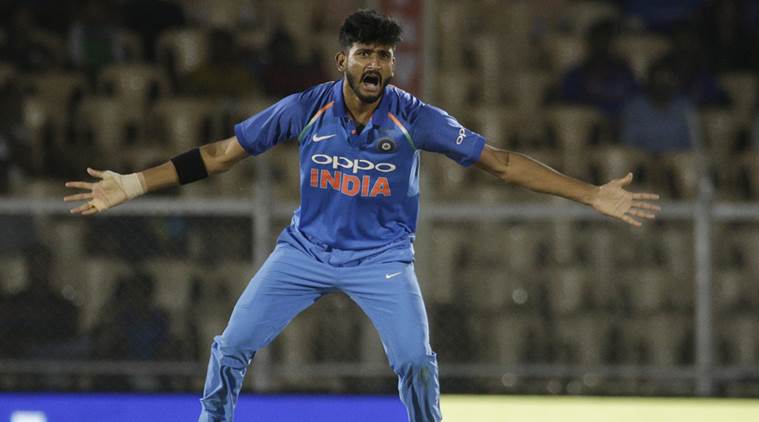 Twenty-year-old Khaleel Ahmed has provided India with a reliable left-arm medium pace option to complement a line-up which includes Chinaman Kuldeep Yadav. (Source: PTI)
Twenty-year-old Khaleel Ahmed has provided India with a reliable left-arm medium pace option to complement a line-up which includes Chinaman Kuldeep Yadav. (Source: PTI)
A stunned silence descended upon Lucknow’s Ekana Cricket Stadium. Out in the middle, Shai Hope, the young Barbadian batting sensation, had just launched Bhuvneshwar Kumar over his head for a six off only the fourth delivery of the innings. However, from the other end, Khaleel Ahmed, the left-arm rookie pacer from Rajasthan, hit his straps immediately and cleaned up Hope in the second over with a beautiful slower delivery. Windies, in pursuit of India’s 195, found themselves in trouble at 7/1.
Back for his second spell, Kumar, picking a cue from Khaleel, brought out his go-to knuckle ball and the rewards were instant. He picked up two wickets and conceded just six more runs in three overs. If these two pacers were not enough, the hapless visitors had to contend with the guile of chinaman bowler Kuldeep Yadav in the middle overs. Complementing them was the searing pace and unusually slingy action of Jasprit Bumrah. In essence, the Windies had to negotiate a four-pronged attack that’s diverse and potent in equal measure. No wonder, they folded up without a fight as India clinched the three-match T20I series with a game to go.
Right through the 1980s and early 90s, the Indian bowling was shouldered by the indefatigable Kapil Dev, with hardly any help from others. The 90s saw the emergence of Javagal Srinath and Venkatesh Prasad, along with Anil Kumble, while the early noughties showcased Harbhajan Singh and Zaheer Khan in their pomp.
They were all match-winners in their own right, but rarely has there been such an abundance of riches in bowling as is the case in the current set-up, with each exponent vastly different from the other. Simply put, India’s bowling has never looked as well-rounded and varied. This gives the team management the luxury to rotate bowlers and keep a tab on their workload.
Apart from the bevy of front-line pacers like Kumar, Bumrah, Umesh Yadav, Ishant Sharma and Mohammed Shami, the IPL has thrown up someone like Khaleel. He may lack the experience of a Kumar or Shami, but the team management believes he is a real find because he combines pace with swing. More importantly, he is seen as the final piece in India’s bowling jigsaw, being a left-armer who adds another dimension this attack hitherto missed.
The 20-year-old has graduated from age-group cricket under the watchful eyes of Rahul Dravid, before Zaheer spotted him in the Indian Premier League and honed his skills further. On Tuesday evening in Lucknow, he put the skids under the Windies with the two prize scalps of in-form Hope and Shimron Hetmyer upfront. After the win, Khaleel said, “Match se pehle lag raha tha ki kahi mera Diwali na nikal jaye chhakke aur chauke ke saath,” he quipped in jest. “But when Hetmyer and Hope got out, we gained control of proceedings and the spinners took over,” he added.
Apart from the bevy of fast bowlers, India in recent times has been blessed with the emergence of two dynamic young wrist spinners in Kuldeep Yadav and Yuzvendra Chahal. Over the last 16 months, these two have replaced finger spinners Ravichandran Ashwin and Ravindra Jadeja in the limited-overs formats. While Jadeja returned to the fold during the Asia Cup in September, a bowler of Ashwin’s calibre still finds himself out of the mix in the shorter formats.
What gives regular skipper Virat Kohli, who is sitting out this T20 series, the confidence to field these young wrist spinners is their ability to provide wicket-taking options even on flat tracks. “Because of them (Chahal and Yadav), we have actually managed to turn flat tracks into exciting wicket-taking opportunities. I’m really excited to see them bowl, because even if the conditions are not overtly in their favour, they have the skill in the wrists. I’m sure other teams are thinking about it. Out of the 50 overs, when you have 20 overs from those two, you know that the opposition team cannot go that far, more so because they know that these two bowlers can get you out in any over,” was Kohli’s assessment before the team’s departure to England in June.
After a severe examination from the pacers, when you have 20 overs from these wrist spinners in ODIs, most opposition teams tend to struggle. Much like their famed top order, India’s bowlers too have played a role in helping their team plant their flag at the summit of the game’s shorter formats.